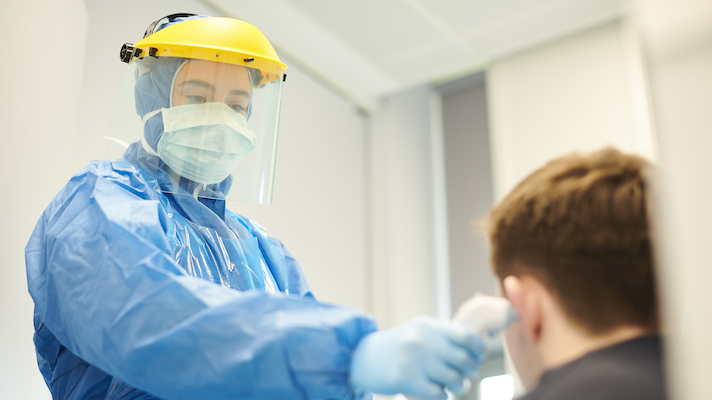- Have any questions?
- 301 841 0012
- hello@zendhealth.com
A nurse practitioner, a doctor and a postal worker share their COVID-19 stories, advice to readers
***Excerpts courtesy of the Healthcare IT News, MobiHealthNews, and Healthcare Finance News
ONE IMPORTANT THING you want the public to know about this crisis?
Take it seriously! Most of us will get the virus; most of us will survive the virus.
Those of us that have a weakened or stressed (which includes both physical and mental) body system WILL DIE! That means that it is up to the majority to protect the minority.
My husband is 77 and has active, but non-progressive cancer. My dad is 70 and has COPD, and my step-mother is 78. My mom is 68, and my step-father is 71 with Parkinson’s.
This doesn’t include my aunts and uncles, who are all over 70, many with significant comorbidities. If they get COVID-19, they will most likely die and I will lose half of my family. If everyone just took the time to evaluate the losses they could have in their own circle of friends and family, maybe they would take this a little more seriously.
As a healthcare worker, it’s not a matter of IF I will get COVID-19, but when I will get it. When that happens, who will be there to take care of me? Are my fears unwarranted? Is it paranoia? Or am I a realist who understands that before this is over, our entire world will be forever changed? This is only the beginning of the pandemic.
~Tabitha Garrison
Licensed Nurse Practitioner
Shenandoah Pain and Palliative Care Clinic
Broadway, Virginia
Adapting a family practice in the time of the coronavirus
April 6
Robert F. Naples SR. D.O.
Family Practice
Cortland, Ohio
I have been in Family Practice for 35 years, and have never seen anything like the COVID-19 pandemic.
This has forced me to implement other options for seeing patients. We now do video and telephone visits. There are currently three providers including myself [at the practice].
The healthy patients come through our front door if they need [to be] seen. Our sick patients are told either to come through the side door, and are given a mask and taken to a room right away, which is cleaned thoroughly after each patient. Or, for the suspected COVID symptoms, they are told to wait in their car as we suit up and see them in their car, and test if necessary. I made an extension for my stethoscope so that the patient [can] hold it on themselves, and I can hear without getting too close to the patient.
We have flags on the outside of rooms to let us know which ones have been cleaned and which ones need cleaned before another patient can be brought into the room.
We have a Quest Draw site on premises so those swabs are processed to the lab swiftly.
We are currently doing 60% office visits and 40% telemedicine visits, but the telemedicine visits are increasing weekly. We have currently been doing this for three weeks. My staff had to decrease their hours and a few have been laid off until we bring them back after this pandemic.
The providers have also been working less hours, but the added stress of dealing with this makes more time away needed. We have times for after hours as well. If a patient needs it we have remote access to charting.
My thoughts are that once this pandemic is over, telemedicine will be here to stay.
It’s a win-win for patients, doctors and insurance companies.
The questions on my mind
April 1
Tabitha Garrison
Licensed Nurse Practitioner
Shenandoah Pain and Palliative Care Clinic
Broadway, Virginia
How have things changed with patients since COVID-19, especially around mental health?
I’ve been impressed with the number of complaints of increased and new symptoms of anxiety related to COVID-19. I find that it has affected me as well. Although I don’t feel anxious, I find myself performing extra education to all of my patients to avoid close contact with others, to stay home. And if they go out, use good hand-washing and don’t touch their faces.
I have some very high-risk patients who will die if they get COVID-19, so we have started a crash course in telemedicine. If the patients don’t have that technology, we are having them stay in their car, drive up to the front of the building, where we can see each other through the window, and we talk on the phone together to get their medications renewed and address any issues they have. I can’t hug my patients anymore, which has been difficult for me.
I can’t sit beside them and hold their hand or pat them on the back. You know, that really depresses me, now that I think about it. So does my anxiety and depression carry over to my patients? to my staff?
What has the response been from patients around the COVID-19 care template and/or NeuroFlow [a tech platform recently implemented as a response to COVID-19] so far?
Those that use the application, like the application. We are still in the first follow-up part after starting NeuroFlow, so we are doing a lot of resending invitations, re-education on the need for the patients to participate in the program, and I am having to remind staff to check on this with every patient, every visit.
Protecting the postal workers
April 10, 2020
Regina Bugbee
District Manager
U.S. Postal Service, Northern New England District
During these challenging times, postal employees are working hard to ensure residents stay connected with their world through the mail. Whether it’s medications, a package, a paycheck, a benefit or pension check, a bill, or a letter from a family member, postal workers understand that every piece of mail is important. While service like this is nothing new to us, we need our communities’ help with social distancing.
For everyone’s safety, our employees are following the social distancing precautions recommended by the Centers for Disease Control and Prevention (CDC) and local health officials. We are asking people to not approach our carriers to accept delivery. Let the carrier leave the mailbox before collecting the mail. With schools not in session, children should also be encouraged to not approach a postal vehicle or carrier.
If a delivery requires a signature, carriers will knock on the door rather than touching the bell. They will maintain a safe distance, and instead of asking for a signature on their mobile device, they’ll ask for the resident’s name. The carrier will leave the mail or package in a safe place for retrieval.
We are proud of the role all our employees play in processing, transporting and delivering mail and packages for the American public. The CDC, World Health Organization and the Surgeon General indicate there is currently no evidence that COVID-19 is being spread through the mail.
With social distancing we can keep the mail moving, while we keep our employees, and the public, safe.


